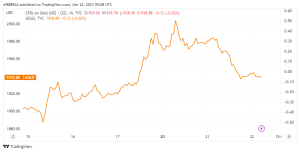The gold price has regressed to the $1,940.00 support level after failing to break over $1,946.00 in the Asian session. The precious metal is projected to continue sideways. As investors are likely to execute significant positions following the release of the Federal Reserve’s interest rate decision (Fed).
The current increase in gold prices was fueled by the Dollar Index’s weakness and worries of a financial sector crisis.
Gold price is battling to stay afloat. Despite the US Dollar Index’s weak performance (DXY). The current increase in the gold price was driven by the USD Index’s weakness and worries of a banking sector meltdown in the United States. Following the failure of three mid-size banks last week.
Moreover US Treasury Secretary Janet Yellen stated that the Fed’s new Bank Term Funding facility and discount window loans are functioning to supply liquidity to the banking sector. Reducing worries of future banking system upheaval. In addition, the announcement injected new life into First Republic Bank’s stock price on Tuesday. Before, the safe-haven attractiveness of gold grew as investors moved their money to bullions to protect themselves from sheer volatility.
The Dollar Index is doing poorly as the probability of the Fed raising interest rates by 25 basis points increase.
Further The US Dollar Index (DXY) has been holding around 103.20. As investors welcome the Fed’s likelihood of raising interest rates by 25 basis points (bp). According to the CME Fed watch tool, there is an 85% likelihood of a 25bp rate rise, which would raise rates to 4.75-5.00%.
Gold Technical Outlook
After a breakdown of the Head and Shoulder chart pattern on an hourly basis. Gold price provided a perpendicular plunge. After a consolidation move, a breakdown of the aforementioned chart pattern signals a bearish reversal. The gold price has fallen to approaching the demand zone, which is set at $1,933.90-1,938.40.

The 20-period Exponential Moving Average (EMA) at roughly $1,950.00 would be a block for Gold bulls.
Meanwhile, the Relative Strength Index (RSI) (14) is swinging between 20.00 and 40.00, indicating that the negative momentum is still active.









